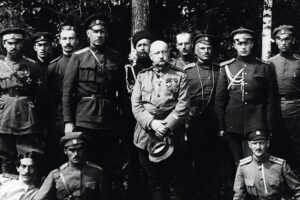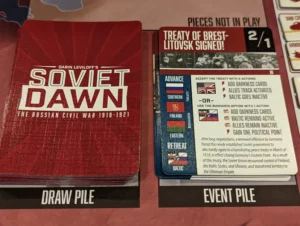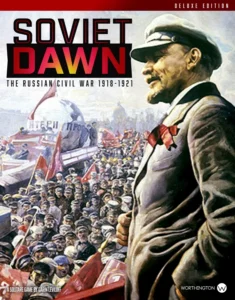Introduction
Soviet Dawn is a realistic and interesting game about the Russian Civil War. It is a single-player game that puts the player in the shoes of the Bolshevik leaders, such as Lenin and Trotsky, during the Russian Civil War. The game provides a realistic approach to the historical context. Moreover, it includes strategic decision-making, historical event cards, and multiple paths to victory that reflect the challenges the Bolsheviks faced.
Rulebook
Historical Background
The Bolshevik Revolution
The Bolshevik Revolution happened on November 6-7, 1917. The Bolsheviks, under the leadership of Vladimir Lenin, overtook the government in a historic event. Lenin and his comrades established a new government based on the concept of Soviet councils. As a result, Lenin became the leader of the first communist state.

Russian Civil War
Following the Bolshevik Revolution, a major battle broke out: the Russian Civil War. There were two primary forces in this violent war, which lasted from 1917 until 1922. On one side was the Red Army, fervent supporters of the Bolsheviks and their communist ideals. On the other side was the White Army, a coalition of anti-Bolshevik forces. After the Red Army’s victory, the Soviet Union was established at the end of 1922. Besides, the Russian Revolution had a significant impact. It started the Cold War between the Soviet Union and the United States and contributed to the spread of communism throughout the world.
Game Mechanics
- Event Cards: The game uses cards to show the historic events and choices made during the Russian Civil War like the Treaty of Brest-Litovsk and the Polish Uprising. It also includes historical people like Lenin and Trotsky.
- Strategic Decision-Making: It also makes players think strategically and manage resources, just like the Bolshevik leaders did during the war. Players have to make decisions about military actions, political changes, and organizing the Red Army. These choices affect how the game progresses.
- Game Order: The game has a specific order of play, including different phases like the Headline Phase and Soviet Action Phase. Each phase lets players do certain things in the game.
- Winning: There are different ways to win in Soviet Dawn. Like holding Moscow or achieving a specific political level. In addition to giving players different goals, it reflects the complexity of the Russian Civil War.
- History: The game shows the history of the Russian Civil War through its themes, event cards, and story content, making players feel like they’re actually part of that period.
- Solo Play: It is a game for one player.
Victory in War

There are many ways to win in the game. As the game progresses, players have to modify their plans in order to deal with the difficulties posed by the Russian Civil War.
Twilight, Darkness, and Dawn are the three decks that players can use to keep control of Moscow. A political track is another strategy of the game that the player must control. In order to win, the player must improve their political status to “9” or “10”. This reflects the real-life Russian Civil War as players experiment various strategies. The game is meant to be difficult as it was for Lenin and his cohorts.
So it is the player’s decisions that define how the game progresses and whether they win or lose in the end. Moreover, they influence when and how event cards are used. This keeps the game exciting and makes it different each time you play. The Darkness cards can be extremely dangerous. This is when enemies attack you the most. The Dawn cards are a sign that things are getting better, as enemies start to give up.
Handling of the political track makes the game more complex and requires thoughtful planning and flexibility. For instance, choices on how to use Action Points, control the Red Army, and try to alter political status directly affect how a player can handle the game’s challenges and aim for a victory.
Losing
When any Front enters Moscow, you lose one political level. If multiple Fronts capture Moscow at the same time, you lose multiple political levels. You can prevent defeat only by removing all Fronts from Moscow before the turn ends.
If you lose, just set up again and start a new story.
Communication
The game immerses players in the Russian Civil War through historical art, event cards and rulebook. They all share the story of that time. The event cards act like a window to the past, showing the events, choices, and problems they experienced. The detailed card stories make players feel involved, making their own game strategies. Since it’s a solo game, it is enjoyable without competition.
Conclusion
The player can actually witness the power struggle among the Bolsheviks in the game. Also, the historically accurate event cards represent the situations they faced. In the rulebook, there is additional historical information about event cards, that can be useful for further strategies. The fact that the player can choose how the story develops contributes to the game’s fun. There are many ways to win, and each choice you make can change the sequence of events and raise the possibility of playing again. It can be difficult to play for someone who does not study history well because it needs players to think about the broader historical dynamics driving their decisions. Like in actual events, decisions have an impact on the results. There is no competition as it is a solo-player game, but the game still offers an engaging experience that blends history with strategy.
